US infantry squads continue to employ World War I concepts with weaponry designed 40 years ago. All firepower is based on direct fire of weak 5.56mm bullets, with the exception of the awkward 40mm grenade launcher attachment. In addition, the rapid urbanization of the world means that most combat will occur in cities, which requires weapons with more punch, especially if an enemy wears modern body armor. Watch this great video that shows no type of 5.56mm bullet can penetrate standard Russian body armor even if fired just 15 yards away. Finally, the development of new electronic gear has added more weight for infantry squads to carry. The only major advance are simple palm-size commercial "walkie-talkies" for every infantryman or helmet-mounted squad intercom, despite paranoid communication officers who insist that all nets must be covered with crypto. Brief squad level chat with very low power radios is unlikely to provide any intel to enemy forces.
The US Army uses squads with a squad leader, medic, and two four-man fire teams. Each fire team has a 5.56mm M249 light machine gun called the Squad Automatic Weapon (SAW) and three M-16 rifles, one with an M203 40mm grenade launcher attachment. In recent years, the Army and Marine Corps unwisely adopted the M4 carbine (a mini M-16) with a shorter barrel that provides even less punch. The Army prefers nine-man squads to easily fit in a single armored personnel carrier or Blackhawk helicopter. The Marine Corps uses the same organization, except with three fire teams to provide 14-man squads.
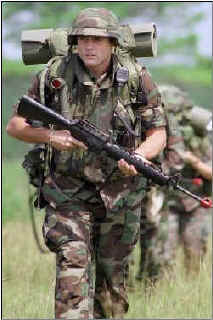 Three fire teams are difficult to control,
yet four-man fire teams are too small. During
peacetime "fully-manned" units are lucky to have 90% of their
men, then take out the sick and injured, a deploying unit is lucky to have
80%. As a result, four-man fire teams go into combat with only 2-3 men. Therefore, the ideal squad should have two five-man fire teams. The extra
riflemen will ensure that fire teams have 3-4 men on average. Planning for five-man rifle teams
is better to "game" this problem,
and a method of keeping replacements on hand. However, three fire teams
used by the Marine Corps would result in 17-man squads. Even if only 14 are present, this is difficult for a squad leader to
control.
Three fire teams are difficult to control,
yet four-man fire teams are too small. During
peacetime "fully-manned" units are lucky to have 90% of their
men, then take out the sick and injured, a deploying unit is lucky to have
80%. As a result, four-man fire teams go into combat with only 2-3 men. Therefore, the ideal squad should have two five-man fire teams. The extra
riflemen will ensure that fire teams have 3-4 men on average. Planning for five-man rifle teams
is better to "game" this problem,
and a method of keeping replacements on hand. However, three fire teams
used by the Marine Corps would result in 17-man squads. Even if only 14 are present, this is difficult for a squad leader to
control.
Two five-man fire teams are ideal. Since one fire team normally provides a base of fire for an attacking fire team, it should become a "weapons team" with heavier weapons while the other serves as the "attack team" with just rifles and grenades. The basic tactic is for the weapons team to provide cover while the attack team dashes forward. Then the weapons teams catches up lugging heavier weapons.
This means the attack team will forgo the M249 SAW light machine gun now found in all fire teams. The SAW is difficult to fire on the move, and at 22 lbs fully loaded, its not something infantrymen can dash forward and "hit and roll". This has been discussed in the pages of the Marine Corps Gazette for many years. One solution may be the M-27 variant developed by the Marine Corps, but it is nearly identical to the M-16. There is much criticism of the M-16 rifle and debate about the value of the smaller M-4 5.56mm carbine. Adopting a larger caliber basic weapon has merit but would take a decade and cost billions of dollars. These are important issues that are not debated here, although Stan Crist's proposal for a long 6mm round looks promising.
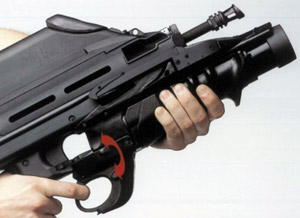 The old M203 grenade launcher attachment is due
for improvement.
FN Herstal developed a version that is easier to fire with a extended
trigger (left) and far more accurate. A laser range finder determines the range to target and then a
ballistic computer, programmed with three firing tables, automatically
calculates the launch angle. LED indicators tell the shooter the aiming angle
required to hit the target. An infrared laser pointer allows aiming and range finding at night. Tests
have shown this weapon to be far more accurate than guessing shots with the
M203. The US Army recent adopted a similar weapon, the M-320, which can be
fired while detached.
The old M203 grenade launcher attachment is due
for improvement.
FN Herstal developed a version that is easier to fire with a extended
trigger (left) and far more accurate. A laser range finder determines the range to target and then a
ballistic computer, programmed with three firing tables, automatically
calculates the launch angle. LED indicators tell the shooter the aiming angle
required to hit the target. An infrared laser pointer allows aiming and range finding at night. Tests
have shown this weapon to be far more accurate than guessing shots with the
M203. The US Army recent adopted a similar weapon, the M-320, which can be
fired while detached.
Another option is to go back to the pure grenadier like those with single-shot M-79 during Vietnam, except use a four-shot weapon with laser fire control. A four-shot 40mm gun firing canister rounds like a huge shotgun is a great close combat weapon. The US Marine Corps adopted this idea and purchased the six-shot Milkor MGL-140 40mm Multiple Grenade Launcher. (below) Finally, as UAVs proliferate, each squad may need a shotgun to skeet shoot them.
Proposed Modern Infantry Squad (12-man goal; 10-man realistic)
Squad Leader - M-16 or shotgun / binoculars / bullhorn / 40mm pistol
Medic - normally attached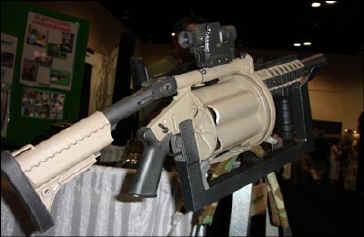
Attack Team
Team leader - M-16 / 40mm pistol
Grenadier - M-16 with M203 (or better)
Rifleman - M-16
Rifleman - Bullpup .338 LM (8.6mm)
Rifleman - M-16 (extra man)
Weapons Team
Team Leader - MGL-140 / 40mm pistol
Machine Gunner - M249 5.56mm SAW
Sharpshooter - Barrett .338 LM (8.6mm)
Rocker - AT-4 RR / 40mm pistol
Rifleman - M-16 (extra man / ammo carrier)
A 7.62mm medium machine gun could be used, but it is heavy and requires two men. Light machine guns that fire the 7.62mm, like a modified M-14, have been proposed but the recoil on full automatic makes accurate fire difficult. The new MK-48 may be the answer, but that is uncertain. As a result, the SAW may remain the best choice. The sharpshooter is not just a sniper, but can shoot through body armor, walls, doors, and cars. A .50 caliber rifle is ideal, but semi-automatic models are too heavy for an infantry squad. A bolt-action .50 cal with five rounds is light enough, but not ideal for an infantry squad.
The best sharpshooter weapon is a debatable issue, but the 15 lb semi-automatic Barrett .338 LM (8.6mm) with a 10-shot magazine is a good choice. (above) The US Marine Corps may add a sharpshooter to each squad soon after recent interventions revealed the need to engage enemy forces nestled among civilians in cities. If the .338 round enters service, it would be nice to provide a member of the attack team with something to can fire that round at close targets, like doors, cars, and body armor; a bullpup with no scope and no bipod to make it lighter and shorter, but with the penetration power provided by an 8.6mm round fired through a long barrel.
RockersAdding a trained rocketman, dubbed "rocker" at the squad level is a major change. When two forces meet in combat, neither is sure what they've encountered and there is fear on both sides during the first minute. If one side seems stronger, the other side is likely to flee. Erwin Rommel was an expert infantryman during World War I and wrote that during an encounter the first side to set up and fire a machine gun usually prevailed. This is why combat vets emphasize the need for maximum firepower upon contact, rather than well-aimed rounds.
Shoulder-fired rockets emerged during latter part of World War II (panzerfausts and bazookas). However, the US military considered them anti-tank weapons and still maintains this view. The Soviets recognized the shock and destructive value of rockets and developed the highly successful RPG. Veterans of the Vietnam, Afghan, and Iraq conflicts will attest to the fear caused by the "swoosh and boom" of RPGs. The movie "Blackhawk Down" demonstrates the power of simple RPGs. During the 1983 Falklands campaign, the British discovered the small LAAW 66mm anti-tank rocket was extremely effective during basic infantry combat.
Nevertheless, American infantry units rely on machine guns for platoon level firepower and keep only a few rockets at the company level, although most US Army platoons have a weapons squad with two rockets. As a result, when squads and even platoons make contact they have no powerful firepower to employ. Firefights often become jack-in-the-box shootouts as infantrymen exchange small arms fire for several minutes until supporting fires can be arranged or heavy firepower brought forward. During this critical phase, wounded suffer, the enemy can maneuver or flee, or may advance and overrun the unit.
Therefore, it is critical that each infantry squad has a rocket that can "swoosh and boom" during the first few seconds of contact. Since they are heavy, rockers may only carry one round. However, if a platoon makes contact with an enemy and immediately pounds them with three big rockets; the psychological effect is tremendous. This firepower implies, "You see that, get ready for more!" Keep in mind that a 40mm grenade delivers a half pound of firepower, while a typical rocket delivers 30 times more BOOM!
An enemy is unlikely to know the platoon has no more rockets or they may be too shocked to even care. If they only have rifles and machine guns, they are likely to flee before more "BOOM" can get them. Well constructed machine gun nests are formidable since they are difficult to destroy with mortars and even artillery. However, if a rocket blows one apart just ten seconds after a shootout begins, nearby machine gunners are unlikely to wait for their turn. They will also find highly accurate .338 rounds zipping through their walls and vision slots annoying.
There are several choices: but the Carl Gustav recoilless rifle (AT-4) seems best. The rocker needs only a 40mm pistol since a serious firefight will produce seriously wounded men in his squad whose rifle he can grab. In some urban warfare operations, he may dash one block to the rear and return with more rockets. Perhaps other members of the squad will carry extra rockets or machine gun ammo, which is another reason to have the extra fire team members. Weapons like the AT-4 can be fired by any infantryman, but a rocker ensures that a well-trained expert is on hand and anxious to fire. Once enemy contact is made, everyone in the squad will eagerly await the "BOOM" of their rocket. Even if nothing is hit, they know the enemy has lost enthusiasm for a fight. A more advanced weapon would use a simple commercial quadrotor UAV, with a claymore like antipersonnel warhead or an anti-tank shaped charge.
A valuable rocket system is the old M202 Flash that is still used by certain US Army units. This is a napalm-type rocket that burns intensely. Strong fortifications can resist infantry rockets, or foliage and camouflage makes targeting difficult. Flash rockets need only explode near a target to produce fire and smoke to blind enemy gunners for several minutes so infantry can advance. In some cases, the enemy is entrenched in a corn field or high grass. Igniting defensive positions using Flash rockets can burn them out, as was done often in the Pacific during World War II using flamethrowers. Flash rockets also provide infantry with something to counter heavy tanks. A flash rocket hitting the thick frontal armor of a heavy tank would burn fiercely for several minutes, blocking the crew's vision and may cause damage, allowing time for heavier weapons to engage or infantry to maneuver.
Despite the "Revolution in Military
Affairs" US military squads
and platoons still rely on light machine guns for serious firepower. Modern squads
must carry heavier firepower in the form of heavy caliber rifles and rockets
for immediate employment. The US Army platoons with a weapons squad should
disband them and organize into three larger and lighter squads as described
here. Since key battles in future wars
will take place in confined cities, infantry squads must modernize with a
variety of weapons with more "BOOM" and fewer "bangs."
Anti-Armor Squad 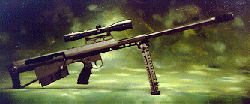 The SASR weighs less than the M240 7.62mm machine gun!
The SASR weighs less than the M240 7.62mm machine gun!
The value of large anti-armor rifles has been proven since World War I. Modern versions like SASR have greater armor penetration ability with high velocity "sabot" rounds, like the tungsten .50 caliber Saboted Light Armor Penetrator (SLAP) round used by the US Army and Marine Corps. A single SLAP round is unlikely to destroy a large target. However, the SASR is semi-automatic, so any bunker, helicopter or vehicle that is penetrated by ten .50 cal rounds within 20 seconds would definitely be put out of action.
SLAP rounds do not just make holes; the impact produces spall fragments that inflict casualties, damage equipment, and ignite fuel and ammunition. Marine Colonel Andrew R. Finlayson wrote in the March 1989 edition of the Marine Corps Gazette: "A 12.7mm armor-piercing, fin-stabilized, discarding sabot round will go in one end and out the other of a Light Armored Vehicle (LAV) without the slightest difficulty." Raufoss .50 cal rounds from Norway, used by the US military, are especially effective since they can penetrate the frontal armor of a Soviet BTR-60 armored vehicle at 1000 meters and explode into 20 fragments.
The SASR's range and rate of fire is superior to man-portable anti-tank missiles. A missile team can launch only a couple rounds before being shot up by advancing armor forces. However, a SASR can deliver over 40 highly accurate rounds in the same time. Ideally, supporting tanks, TOWs, and air support would deal with heavy tanks, while SASRs shoot up light armor. However, highly accurate anti-armor rounds can kill tank commanders standing in their hatches at 1800 meters, break tank tracks, damage gun sights, and put holes in the main gun itself. In addition, many modern tanks have reactive armor to protect against shaped charges. A SASR firing high explosive rounds can explode these plates, causing confusion and possibly panic among the crew, while injuring nearby infantrymen.
Meanwhile, tanks are hit with numerous AT-4 rockets until a lucky hit disables or destroys. Infantry squads require annual refresher training on these weapons. An adequate stockpile of these anti-armor weapons and munitions must be maintained to allow rapid distribution when required. Heavy armor squads will be less mobile with this heavier weaponry, but can put up a good fight when they encounter enemy armored vehicles.
What is a Carbine?
Most US Army officers are unaware of the purpose of carbines, so here is a lesson. Truck drivers, supply, and headquarters personnel may encounter enemy commandos and need something more than a pistol for self-defense. Rifles are large and heavy. Toting them around while doing support work is difficult. As a result, carbines were developed for occasional close-in skirmishes by rear area troops. These are roughly half the size and weight of standard infantry rifles, with half the range and stopping power. Their lightweight metal parts heat up fast from sustained fire and cause jams, but they are much better than pistols. The American M-4 carbine is shown below, basically a downsized M-16.
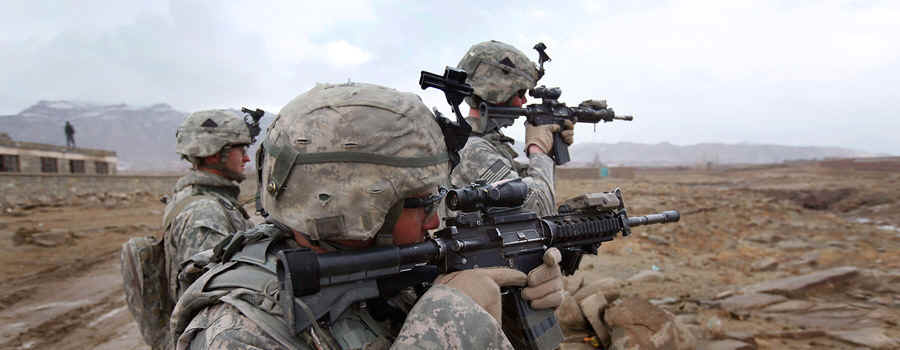
After decades of complaints that the M-16's 5.56mm round is too weak, and whilst better body armor proliferates, one expects to see the introduction of bigger guns with bigger bullets. Yet colonial duty in Iraq led to the adoption of a "cool" garrison weapon, the M-4 carbine, as the basic US Army infantry rifle. Effective range drops from 600 meters with the latest M-16A4 to 300 meters with the M-4, and less if they don't brace it in their shoulder. The shorter barrel means less accuracy and less penetrating power. No bayonet, and no using the rifle butt to "hit and roll" or to whack bad guys.
Retired Army Colonel Douglas Macgregor noted a few years ago that the US Army has become a constable force dedicated to colonial duties, like the British Army prior to World War II. That army was full of "combat vets" accustomed to chasing off and hunting down insurgents in the British empire. When World War II occurred, these soldiers were not prepared to fight a serious enemy with similar equipment and training. The performance of the British Army from 1940 through 1942 was pathetic. British troops often fled whenever they encountered an attacking enemy, not just in France, but also North Africa, Malaysia, and Burma.
More evidence of a leadership weakness in the US Army was the formation of LAV "Stryker" brigades, suitable for constable duties, but not a real war. The continued emphasis on airborne/airmobile/aviation brigades is further proof, which ignore advances in air defense weaponry and the math of logistics. US Army General's recent speeches about the need to rapidly deploy light brigades to Asia within days demonstrates their ignorance of warfare. Had the US Army dispatched an airborne division to the Philippines in 1942, the Japanese would have captured a lot more prisoners.
The most recent proof of incompetence are leaked details about the infamous Battle of Wanat in Afghanistan where nine American soldiers were killed. The Afghans attacked and engaged these soldiers in serious combat. Even though they were in defensive positions in a hostile area, they were armed with M-4 carbines that overheated and jammed. The after-action discussion focused on improving the M4 carbine. That is the wrong issue. Why were these infantrymen not armed with rifles!
While the M-16 rifle doesn't have the power of most combat rifles, it has more than the M-4, and a heavier barrel and components allow more sustained fire. In 2010, Marine Corps Commandant James Conway explained why the Marines would not follow the Army's change to the M-4 carbine:
"Marines like that M4 carbine because it looks cool. And I've had some Marines complain to the chairman of the Joint Chiefs of Staff saying 'you know, the officers are getting these things, but we're still having to carry this rifle.' Well, the Marine Corps will always be a rifle Marine Corps. The carbine is an extension of the pistol, not a reduction of a rifle. And in the Afghanistan scenario where you're shooting long distances you gotta be able to reach out and touch 'em. And a carbine is just not designed to do that."

Unfortunately, General Conway was overruled by the next Commandant, because many Marines prefer the smaller and lighter M4. But today's Marines see no serious combat, and some would prefer to carry pistols, because they are lighter, smaller, and easier to handle than the M4.
Generals brag that modern body armor and helmets can stop 7.62mm rounds (center pictured above), but can't seem to grasp that foreign armies have them too. While shifting an entire army up from the 5.56mm (leftmost pictured) may be difficult, squads should have two .338LM (8.6mm/rightmost pictured) rifles; a scoped sharpshooter rifle and a bullpup with punching power needed to blast through walls, doors, cars, and body armor. Meanwhile, issue infantrymen M-16A4 rifles! It is also a good idea to adopt a 8.6mm machine gun (pictured) for weapons platoons. While the .50 (12.7mm) is great, it's too heavy for most infantry operations. Merging the 7.62mm and .50 cal. ammo, weapons, and training into one system that fires a .338 (8.6mm) round is a great solution.
©2015 www.G2mil.com
